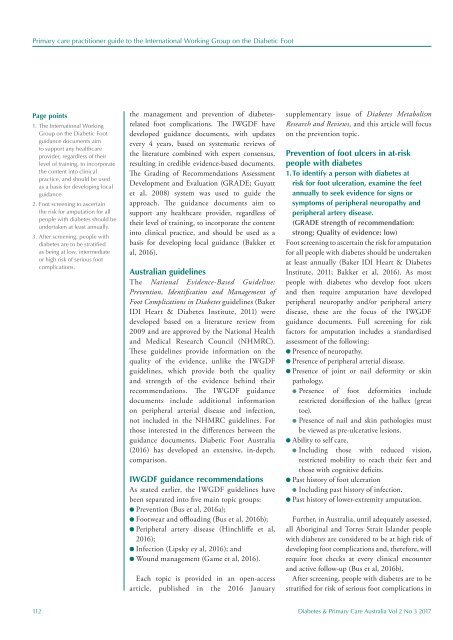DPCA 2-3_entire_v3
Create successful ePaper yourself
Turn your PDF publications into a flip-book with our unique Google optimized e-Paper software.
Primary care practitioner guide to the International Working Group on the Diabetic Foot<br />
Page points<br />
1. The International Working<br />
Group on the Diabetic Foot<br />
guidance documents aim<br />
to support any healthcare<br />
provider, regardless of their<br />
level of training, to incorporate<br />
the content into clinical<br />
practice, and should be used<br />
as a basis for developing local<br />
guidance.<br />
2. Foot screening to ascertain<br />
the risk for amputation for all<br />
people with diabetes should be<br />
undertaken at least annually.<br />
3. After screening, people with<br />
diabetes are to be stratified<br />
as being at low, intermediate<br />
or high risk of serious foot<br />
complications.<br />
the management and prevention of diabetesrelated<br />
foot complications. The IWGDF have<br />
developed guidance documents, with updates<br />
every 4 years, based on systematic reviews of<br />
the literature combined with expert consensus,<br />
resulting in credible evidence-based documents.<br />
The Grading of Recommendations Assessment<br />
Development and Evaluation (GRADE; Guyatt<br />
et al, 2008) system was used to guide the<br />
approach. The guidance documents aim to<br />
support any healthcare provider, regardless of<br />
their level of training, to incorporate the content<br />
into clinical practice, and should be used as a<br />
basis for developing local guidance (Bakker et<br />
al, 2016).<br />
Australian guidelines<br />
The National Evidence-Based Guideline:<br />
Prevention, Identification and Management of<br />
Foot Complications in Diabetes guidelines (Baker<br />
IDI Heart & Diabetes Institute, 2011) were<br />
developed based on a literature review from<br />
2009 and are approved by the National Health<br />
and Medical Research Council (NHMRC).<br />
These guidelines provide information on the<br />
quality of the evidence, unlike the IWGDF<br />
guidelines, which provide both the quality<br />
and strength of the evidence behind their<br />
recommendations. The IWGDF guidance<br />
documents include additional information<br />
on peripheral arterial disease and infection,<br />
not included in the NHMRC guidelines. For<br />
those interested in the differences between the<br />
guidance documents, Diabetic Foot Australia<br />
(2016) has developed an extensive, in-depth,<br />
comparison.<br />
IWGDF guidance recommendations<br />
As stated earlier, the IWGDF guidelines have<br />
been separated into five main topic groups:<br />
l Prevention (Bus et al, 2016a);<br />
l Footwear and offloading (Bus et al, 2016b);<br />
l Peripheral artery disease (Hinchliffe et al,<br />
2016);<br />
l Infection (Lipsky ey al, 2016); and<br />
l Wound management (Game et al, 2016).<br />
Each topic is provided in an open-access<br />
article, published in the 2016 January<br />
supplementary issue of Diabetes Metabolism<br />
Research and Reviews, and this article will focus<br />
on the prevention topic.<br />
Prevention of foot ulcers in at-risk<br />
people with diabetes<br />
1. To identify a person with diabetes at<br />
risk for foot ulceration, examine the feet<br />
annually to seek evidence for signs or<br />
symptoms of peripheral neuropathy and<br />
peripheral artery disease.<br />
(GRADE strength of recommendation:<br />
strong; Quality of evidence: low)<br />
Foot screening to ascertain the risk for amputation<br />
for all people with diabetes should be undertaken<br />
at least annually (Baker IDI Heart & Diabetes<br />
Institute, 2011; Bakker et al, 2016). As most<br />
people with diabetes who develop foot ulcers<br />
and then require amputation have developed<br />
peripheral neuropathy and/or peripheral artery<br />
disease, these are the focus of the IWGDF<br />
guidance documents. Full screening for risk<br />
factors for amputation includes a standardised<br />
assessment of the following:<br />
l Presence of neuropathy.<br />
l Presence of peripheral arterial disease.<br />
l Presence of joint or nail deformity or skin<br />
pathology.<br />
l Presence of foot deformities include<br />
restricted dorsiflexion of the hallux (great<br />
toe).<br />
l Presence of nail and skin pathologies must<br />
be viewed as pre-ulcerative lesions.<br />
l Ability to self care.<br />
l Including those with reduced vision,<br />
restricted mobility to reach their feet and<br />
those with cognitive deficits.<br />
l Past history of foot ulceration<br />
l Including past history of infection.<br />
l Past history of lower-extremity amputation.<br />
Further, in Australia, until adequately assessed,<br />
all Aboriginal and Torres Strait Islander people<br />
with diabetes are considered to be at high risk of<br />
developing foot complications and, therefore, will<br />
require foot checks at every clinical encounter<br />
and active follow-up (Bus et al, 2016b).<br />
After screening, people with diabetes are to be<br />
stratified for risk of serious foot complications in<br />
112 Diabetes & Primary Care Australia Vol 2 No 3 2017
















